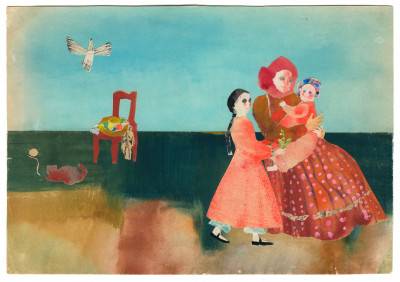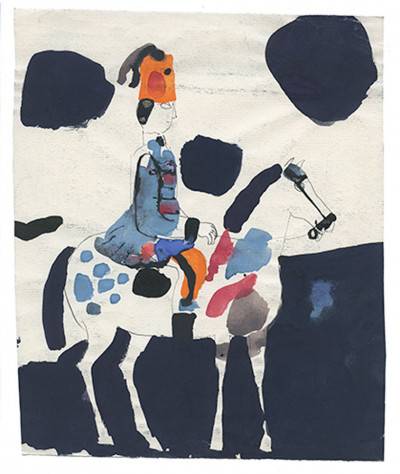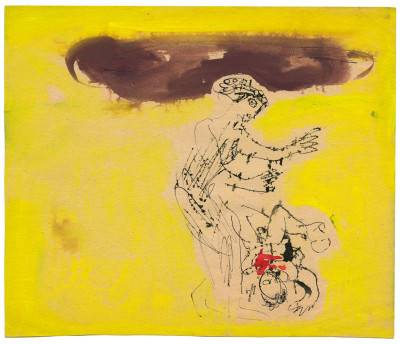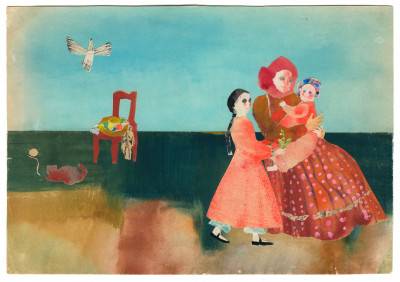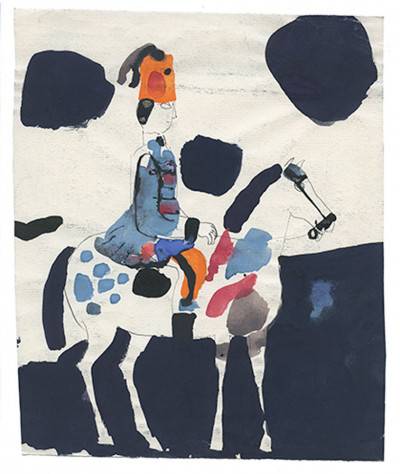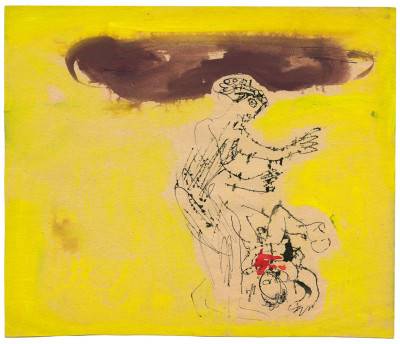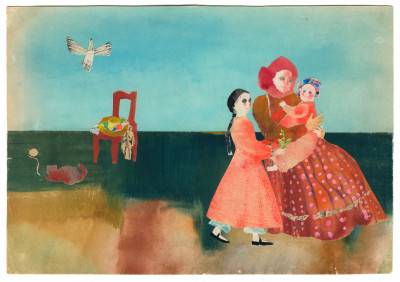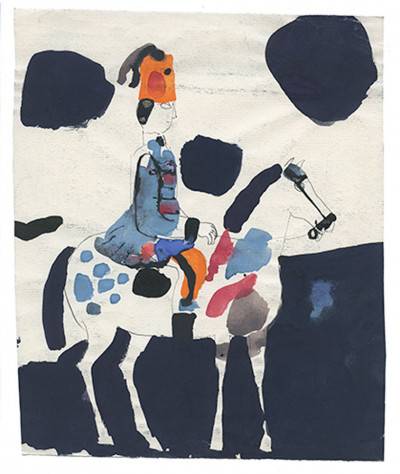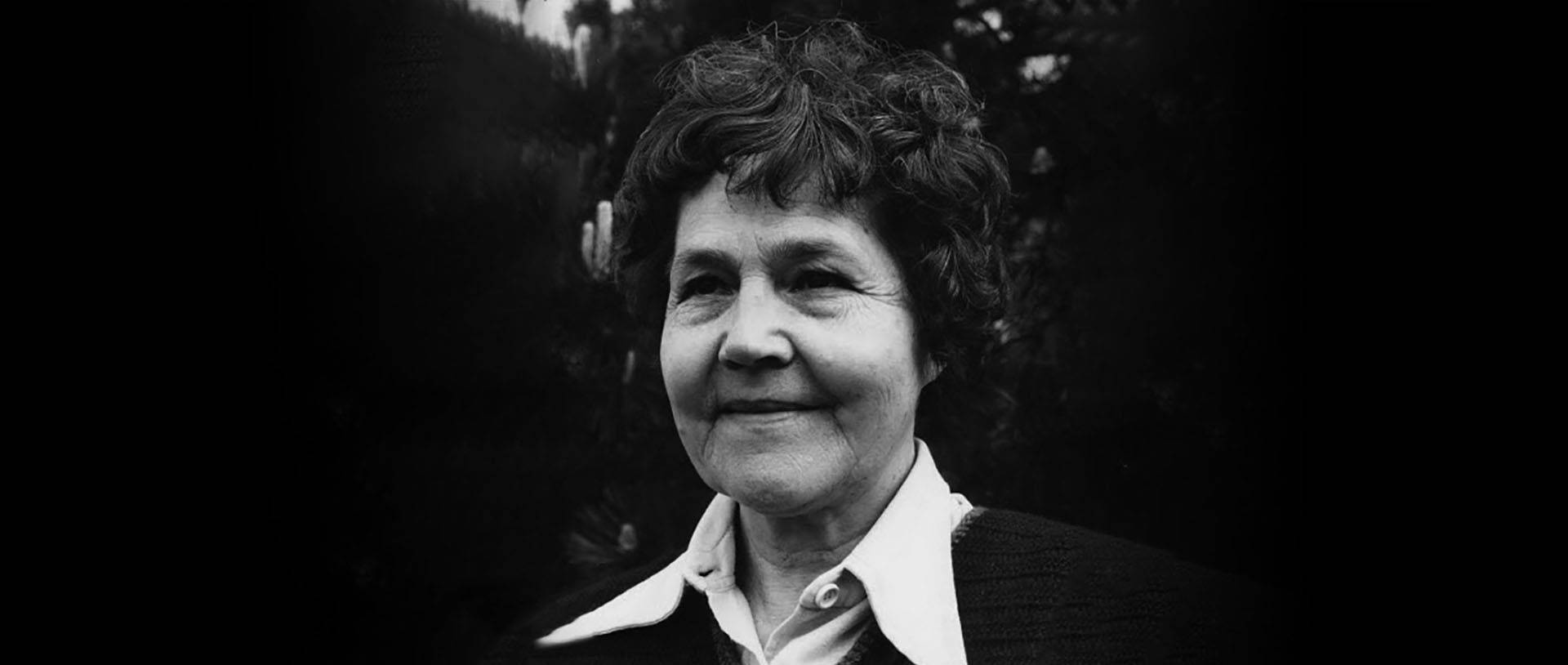

We know Viera Kraicová as a painter “with stars in her eyes”. Painting for her was an instrument of clairvoyance, often revealing horizons of shapes and colours that were unsuspected and astonishing, explosive products of her energy as draughtsman and painter. Her art was close to the pure conception of children’s work or the art of modern primitives, so-called art brut, art in the raw state. But there was this difference between them, and it was not a small one: in Kraicová’s case her playfulness, purity of heart, immediate and sometimes enchantingly childlike “innocence of the eye”, though they welled from the natural human being, nonetheless were controlled by a creative desire that was lacking in the artists of naturalness and natural settings. One finds a notable resemblance here and there, but in modern art that is not accidental... And precisely this conception of creative work was transmitted to another area of her artistic activity, which was illustration.
Viera Kraicová the illustrator is possibly less well known as a painter. But that in no way detracts from the significance and power of this sphere of her activity. She devoted herself to illustration, one may say, systematically and perseveringly, from the mid-1950s to the early 1980s, and her intended audience was most frequently the child reader. Although she had not been specifically trained in this field of art, she compensated for this by self-study and seeking her own means of expression. She approached the tasks of illustration in a very honest way and developed a characteristic and genuinely modern signature, connecting not only with the book’s content but also its aim and object. Fedor Kriška spoke in this regard of a “metamorphosis”. Her illustrative work was highly rated, and rightly so. In the illustrations of children’s books we can find the basic principles of her work in crystalline form, though transformed through the specific filter of the genre. Kraicová’s illustration was not just an epic accompaniment to a literary text, simply comprehensible at a glance. Even though she respected the parameters of illustration aimed at children, and their emotional world was close to her (children and their games often served as the narrative frame of her pictures), by its conception her illustration was artistically autonomous. Either she founded it on the power of expressive colours, or contrastingly she chose a striking black-and-white range, complemented by colour as accentuation. Lapidary use of a simplifying reduction of shapes; the dramatic power of a somewhat primitivising, even childlike, and apparently uncertainly flowing, lyrically felt line ‒ by such means the books illustrated by Kraicová stimulated and cultivated their readers’ imagination. With a contemporary sensibility recast in what was then, in Czechoslovakia, the new technique of drawing and painting collage, she illustrated Němcová’s Babička (Granny, 1965, published in four editions, GMB), Sedmikráska by Mária Rázusová-Martáková (Daisy, 1966), and Erben’s Zlatovlásku (Goldilocks, 1968, GMB). Most frequently, however, she drew and painted in an “airy” watercolour, or tempera and ink; illustration came to have ever more influence on her free painting, and vice versa. In the 1960s her illustration of Publius Ovidius Naso’s Premeny (Metamorphoses, 1969, SNG) helped prepare her for her supreme achievements on the small space. Given that she was narrating poetic events of antique mythology pictorially, her expression became more figurative to a certain extent, but it lost nothing of its poetic and painterly power. She based her expressive capacity on a richly coloured, resonant surface and pen sketching for precise detail. She attained to an eastern, or even “cosmic”, simplicity in her illustration of a selection of folk ballads Išlo dievča po vodu (The Girl Went for Water, 1969, GMB) and Čakanky by Ľudmila Podjavorinská (Chicory, 1972, SNG). How conscientiously she approached her tasks as an illustrator is attested by the selection presented in the current exhibition in Toto! Gallery. Even though her best illustrations have found their way to state and public collections, many variants and preparatory (artistically distinctive) works remained among her effects.
Once I wrote that the proverbial “heart” of Kraicová’s work, the imaginary centre of her artistic world, her fairytale thirteenth chamber, lay hidden in her painterly miniatures, in little sketches created for joy and pleasure. But having become more thoroughly familiar with her illustrative work, I wish to amend this statement: her true ‒ human ‒ heart was in the work she created for children. You will appreciate that when you see this exhibition.
text: Katarína Bajcurová
translation: John Minahane
Viera Kraicová
1920 – born on July 5 in Modra
1940 – 1944 – studied at the Department of Drawing and Painting in the Slovak Technical University in Bratislava
1945 – 1950 – studied at the Academy of Fine Arts in Prague
1952 – 1955 – was assistant to Prof. Ján Želibský at the Academy of Fine Arts and Design in Bratislava
1955 – began to work freelance
1966 – moved from Modra to Bratislava, where she created a studio in the artists’ colony on Drotárská cesta
1966, 1967, 1968, 1975, 1980 – was awarded honourable recognitions and prizes for her illustrative work in Czechoslovakia’s Most Beautiful Book Competition
1968 – won the Cyprián Majerník Prize
1987 –won the Ľudovít Fulla Prize for her many years of illustrative work for children
1996 – held an exhibition of collected work in the Slovak National Gallery in Bratislava
2012 – died April 29 in Bratislava
Books Illustrated
Kukučín, Martin: Do školy (To School). Bratislava : SNDK, 1955.
Němcová, Božena: Babička (Granny). Bratislava : Mladé letá, 1965, 1967, 1972, 1978.
Rázusová-Martáková, Mária: Sedmikráska (Daisy). Bratislava : Mladé letá, 1966, 1969.
Rázusová-Martáková, Mária: Chlapčekovo leto (A Boy’s Summer). Bratislava : Mladé letá, 1967.
Erben, Karel Jaromír: Zlatovláska (Goldilocks). Bratislava, Mladé letá, 1968.
Išlo dievča po vodu. Slovenské ľudové balady (Slovak Folk Ballads). Bratislava : Mladé letá, 1969.
Ovídius Naso, Publius: Premeny (Metamorphoses). Bratislava : Mladé letá, 1970.
Podjavorinská, Ľudmila: Čakanka (Chicory). Bratislava : Mladé letá, 1972.
Jančová, Mária: Braček a sestrička (Little Brother and Little Sister). Bratislava : Mladé letá, 1973, 1980.
Rúfus, Milan: Kniha rozprávok (Book of Fairytales). Bratislava : Mladé letá, 1974, 1979.
Ondrejka, Kliment: Poďte, deti, medzi nás (Come Here to Us, Children). Bratislava : Mladé letá, 1980.
Horov, Pavol: Moje poludnie (My Noon). Bratislava : Slovenský spisovateľ, 1981.
Kovaľ, Jurij: Sklený rybník (The Glass Fishpond). Bratislava : Mladé letá, 1983.
Podjavorinská, Ľudmila: Len lipa šumela (Only the Lime Was Rustling). Bratislava : Slovenský spisovateľ, 1982.
Prokešová, Viera: Vanilka (Vanilla). Bratislava : Petrus, 2007.
